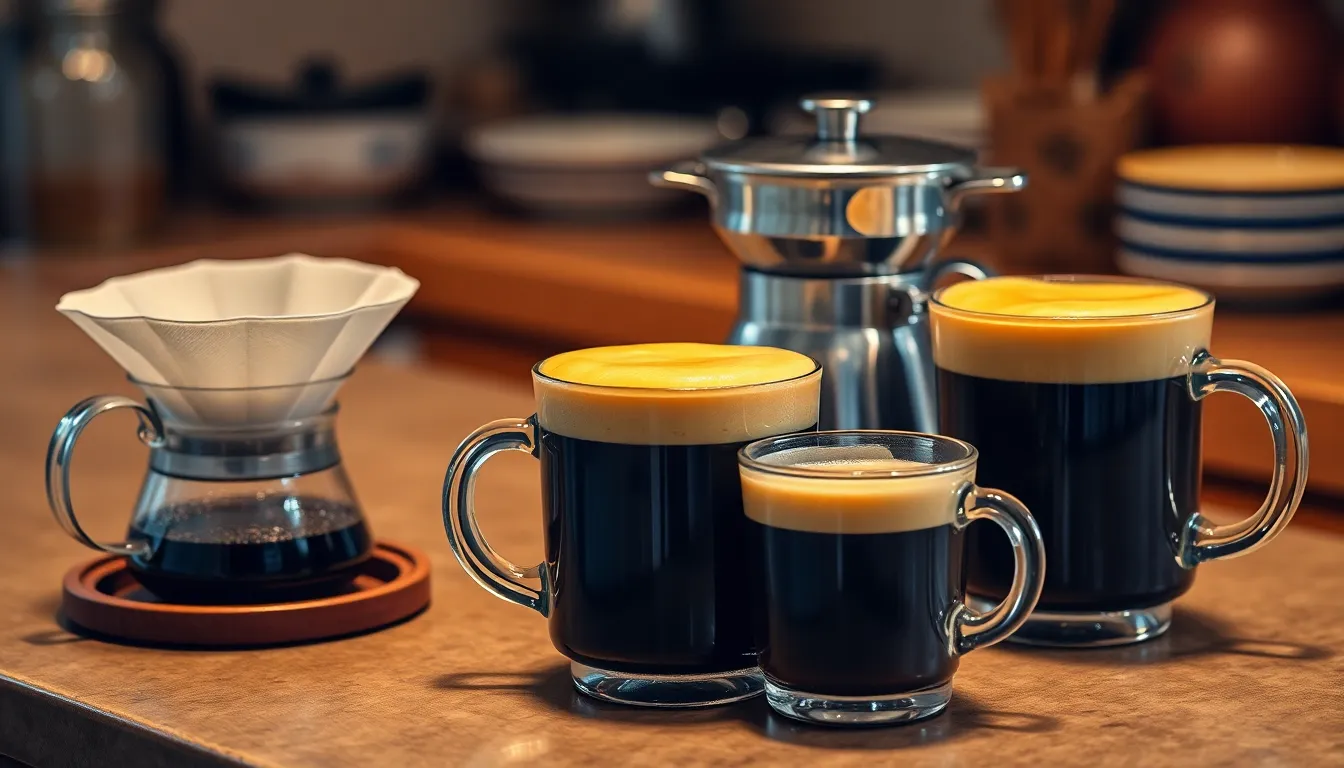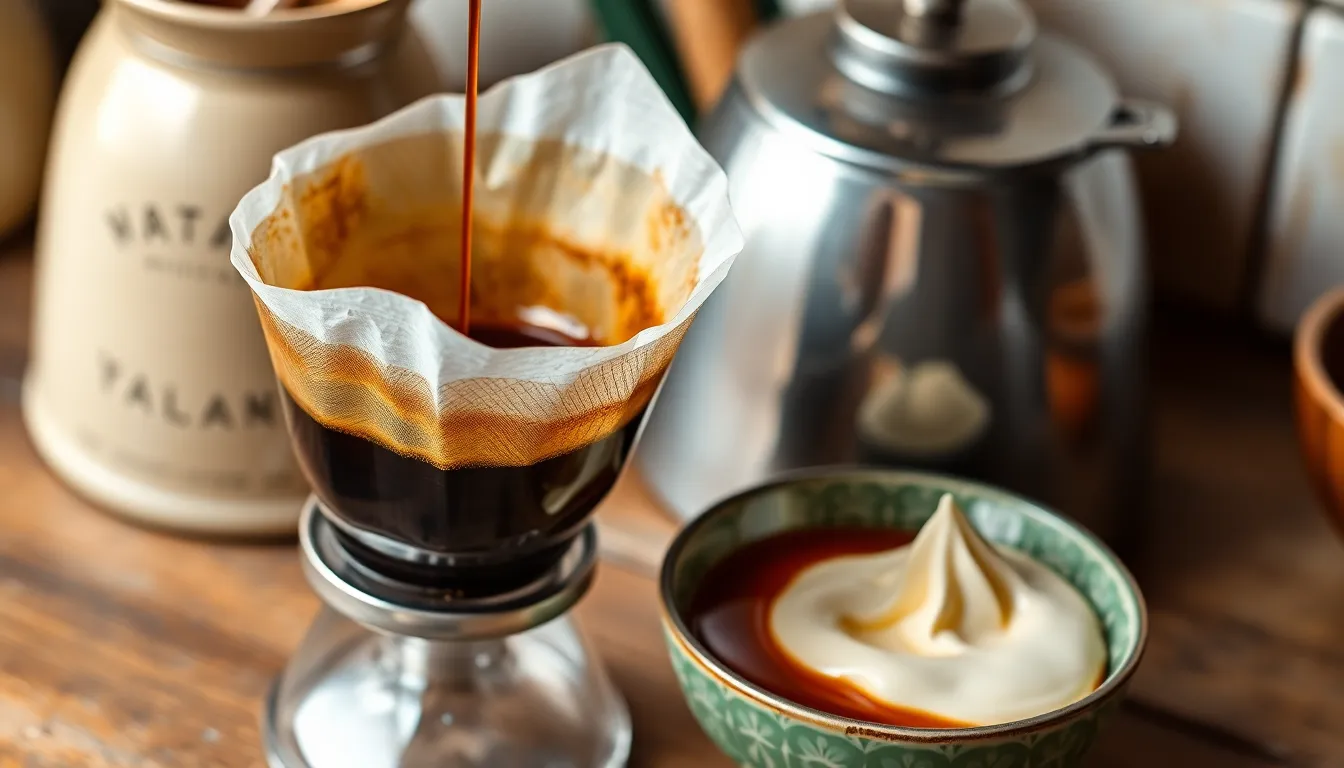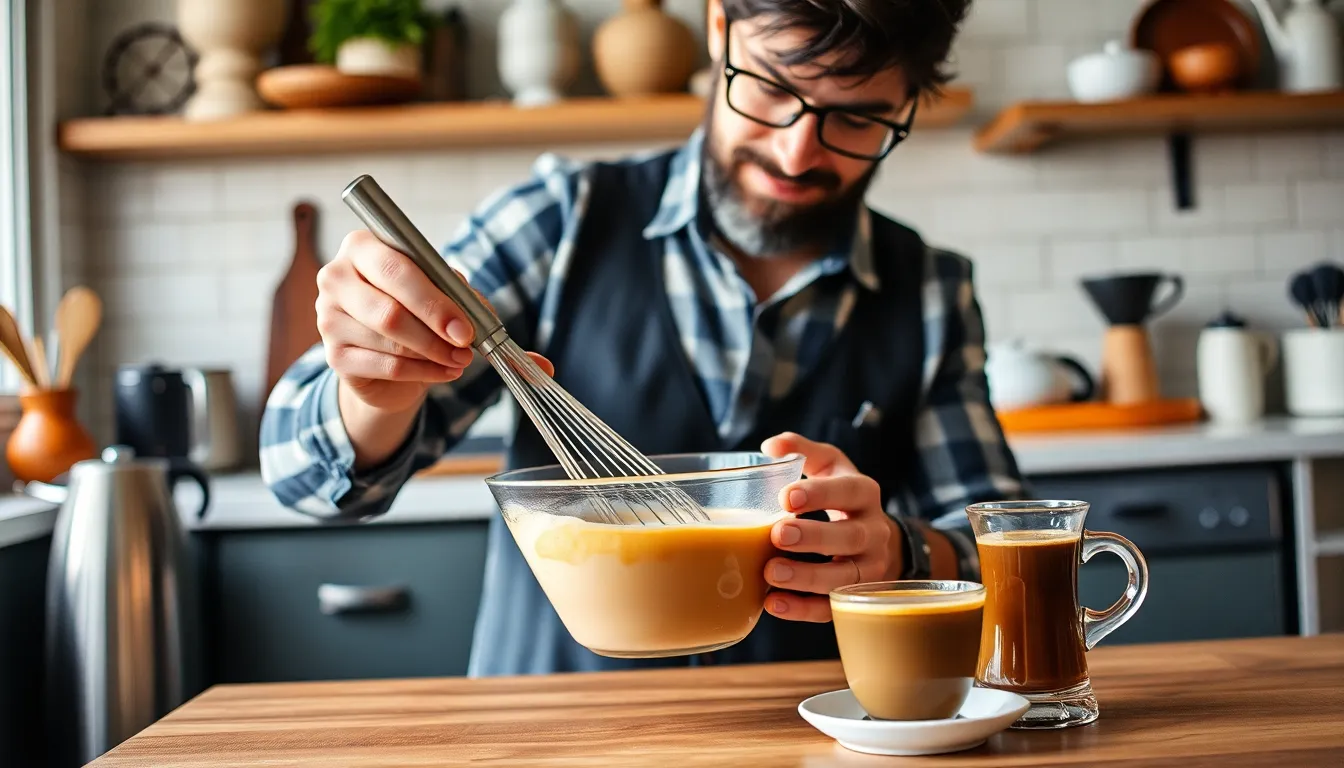We’ve discovered one of Vietnam’s most beloved coffee creations that’ll completely transform your morning routine. Vietnamese egg coffee combines the bold richness of Vietnamese coffee with a luxuriously creamy egg foam topping that tastes like liquid tiramisu. This ingenious drink was born in 1946 at Hanoi’s legendary Giang Cafe when egg yolks became a clever substitute for scarce milk during wartime.
What makes this coffee so irresistible is the velvety meringue-like foam that sits atop strong Vietnamese coffee. The contrast between the bitter coffee below and the sweet creamy layer above creates an experience that’s both comforting and sophisticated. We’ll show you how to recreate this café specialty at home using simple ingredients you likely already have.
The best part? You don’t need any fancy equipment to master this technique. With just a whisk and some patience you’ll be sipping café-quality Vietnamese egg coffee that rivals what you’d find in the bustling streets of Hanoi.
What Is Vietnamese Egg Coffee
Vietnamese egg coffee, known locally as “cà phê trứng,” transforms a traditional cup of coffee into an indulgent dessert-like beverage. We create this unique drink by combining robust Vietnamese coffee with a luxurious foam made from egg yolks, sugar, and condensed milk.
The preparation creates two distinct layers that work in perfect harmony. Strong coffee forms the base, typically brewed using dark roast beans in a traditional Vietnamese phin filter. Above this sits a cloud of golden foam that delivers sweetness and richness with every sip.
We often describe the egg foam as having a consistency similar to zabaglione or crème brûlée. The mixture whips into a light, airy texture that floats elegantly on top of the coffee. This foam acts as both a flavor enhancer and a natural insulator, keeping the coffee warm while you savor each spoonful.
The taste profile offers remarkable complexity even though its simple ingredients. Bitter coffee notes balance against the sweet, custard-like foam, creating a beverage that satisfies both coffee lovers and dessert enthusiasts. Each sip delivers contrasting temperatures and textures, with the warm coffee mixing with the cooler foam.
This specialty drink represents more than just a coffee preparation method. Vietnamese egg coffee embodies the resourcefulness and creativity of Vietnamese coffee culture, transforming basic ingredients into something extraordinary. The beverage has become a cultural symbol, representing innovation born from necessity and refined through generations of coffee artisans.
Essential Equipment and Tools

Creating authentic Vietnamese egg coffee at home requires exact equipment that ensures both safety and optimal flavor extraction. We recommend gathering these essential tools before beginning your brewing journey.
Vietnamese Coffee Filter serves as the cornerstone of authentic preparation. This traditional phin filter produces the concentrated coffee base that forms the foundation of our egg coffee. We can substitute with a French press or espresso machine if a phin filter isn’t available, though the flavor profile will differ slightly from the traditional preparation.
Double Boiler or Heatproof Bowl provides the controlled heat necessary for safely pasteurizing egg yolks. We place this setup over simmering water to gently warm the egg mixture to 160°F, eliminating any food safety concerns while creating the perfect custard-like consistency.
Whisk or Handheld Electric Mixer transforms our egg yolk mixture into the signature fluffy foam that crowns Vietnamese egg coffee. We start with a whisk for initial mixing, then switch to an electric mixer to achieve the light, airy texture that resembles fresh whipped cream.
Glass Coffee Mugs showcase the beautiful layered presentation that makes Vietnamese egg coffee so visually appealing. We prefer clear glass vessels because they highlight the contrast between the dark coffee base and the golden foam topping, creating an Instagram-worthy presentation.
| Equipment | Purpose | Temperature/Setting |
|---|---|---|
| Vietnamese Filter | Coffee brewing | Hot water (195-205°F) |
| Double Boiler | Egg pasteurization | 160°F |
| Electric Mixer | Foam creation | Medium-high speed |
| Glass Mugs | Serving presentation | Room temperature |
Our equipment selection focuses on achieving both safety and authenticity. The double boiler ensures we reach the proper temperature for pasteurizing eggs, while the traditional Vietnamese filter creates the robust coffee base that balances perfectly with our creamy foam topping.
Ingredients

Creating authentic Vietnamese egg coffee requires just a handful of simple ingredients that work together to produce this luxurious beverage. We’ve organized our ingredient list into two essential components to make preparation straightforward.
For the Coffee Base
We need these ingredients to create the robust coffee foundation:
- 3 teaspoons Vietnamese coffee powder (or similar dark roast coffee)
- Boiling water heated to 200°F/93°C for optimal brewing
- 4 tablespoons ground coffee (alternative measurement when using a Vietnamese phin filter)
The Vietnamese coffee powder delivers the authentic bold flavor that serves as the perfect base for our egg cream topping. We recommend using a traditional Vietnamese phin filter for the most authentic brewing experience.
For the Egg Cream
Our creamy foam layer requires these essential ingredients:
- 1-2 egg yolks (adjust quantity based on desired creaminess level)
- 2-4 tablespoons sweetened condensed milk
- 1/2 teaspoon vanilla extract (optional for enhanced flavor)
- 1 teaspoon granulated sugar (optional for additional sweetness)
The egg yolks create the signature custard-like texture while the sweetened condensed milk adds both sweetness and richness. We use fresh egg yolks for the best foam consistency and recommend pasteurizing them for food safety when serving to vulnerable populations.
Instructions

We’ll guide you through the three essential steps to create this Vietnamese delicacy at home. Following these detailed instructions will ensure you achieve the perfect balance of strong coffee and luxurious egg foam.
Preparing the Vietnamese Coffee Base
Start by heating water to boiling temperature (200°F/93°C) for optimal extraction. Place 3 teaspoons of Vietnamese coffee powder into your phin filter and position it over a heat-resistant glass cup. Pour a small amount of hot water over the grounds to bloom them for 20 seconds. Add the remaining boiling water slowly and allow the coffee to drip through the filter completely. This process typically takes 4-5 minutes and produces the concentrated coffee base essential for authentic Vietnamese egg coffee. Keep the brewed coffee warm by placing the cup in a bowl of hot water while you prepare the egg mixture.
Making the Egg Cream Mixture
Separate 1-2 fresh egg yolks from the whites, discarding the whites or saving them for another recipe. For food safety, consider pasteurizing the eggs by submerging them in 140°F water for several minutes before separating. Combine the egg yolks with 2-4 tablespoons of sweetened condensed milk in a mixing bowl. Add 1/8 teaspoon of vanilla extract if desired for enhanced flavor. Whisk the mixture vigorously by hand for 2-3 minutes until it begins to lighten in color and increase in volume. For optimal results, use a handheld electric mixer and beat for 3 minutes until the mixture becomes frothy, fluffy, and pale yellow. The consistency should be airy enough to float on the coffee surface.
Assembling the Egg Coffee
Pour the hot concentrated coffee into your serving glass, filling it about two-thirds full. Gently spoon the fluffy egg cream mixture on top of the coffee, creating a distinct layer that sits beautifully above the dark coffee. The foam should maintain its structure and not immediately sink into the coffee. Dust the top lightly with ground cinnamon or cocoa powder for added flavor and visual appeal. Serve immediately while the coffee remains hot and the egg foam maintains its creamy texture. The contrast between the bitter coffee base and sweet egg cream creates the signature taste experience of authentic Vietnamese egg coffee.
Serving Suggestions

We recommend serving Vietnamese egg coffee in clear glass mugs to showcase the beautiful layered presentation that makes this beverage so visually appealing. Our preferred approach involves presenting the drink immediately after preparation while the egg foam maintains its peak fluffiness and the coffee remains at optimal temperature.
Garnish with ground cinnamon for added flavor and visual appeal. We find that a light dusting creates an aromatic enhancement that complements the coffee’s robust notes while adding warmth to the creamy egg mixture. Cocoa powder serves as an excellent alternative garnish that introduces subtle chocolate undertones.
Adjust the amount of sweetened condensed milk to your taste preferences. We suggest starting with 2 tablespoons for those who prefer less sweetness and gradually increasing to 4 tablespoons for a more dessert-like experience. This customization allows each person to find their perfect balance between the coffee’s natural bitterness and the foam’s sweetness.
Serve as a dessert-like coffee treat during afternoon gatherings or as an indulgent morning beverage. We position this drink as a bridge between traditional coffee service and elegant dessert presentation. The rich texture and luxurious appearance make it particularly suitable for special occasions or when entertaining guests who appreciate unique culinary experiences.
Provide small spoons alongside each serving to help guests mix the layers or enjoy the foam separately before sipping the coffee underneath. We encourage serving at a comfortable temperature that allows for immediate enjoyment while preventing any risk of burning from the hot coffee base.
Consider pairing with light Vietnamese pastries or simple butter cookies that won’t compete with the complex flavors already present in the beverage. Our experience shows that minimal accompaniments work best to highlight the drink’s sophisticated flavor profile.
Tips for Perfect Vietnamese Egg Coffee

Creating the perfect Vietnamese egg coffee requires attention to both the coffee brewing technique and the egg cream preparation. We’ll guide you through the essential tips that ensure exceptional results every time.
Coffee Brewing Tips
Use a traditional Vietnamese coffee filter for the most authentic and concentrated coffee base. This phin filter allows the coffee to drip slowly and creates the strong flavor profile essential for balancing the rich egg cream.
Choose Vietnamese coffee brands like Trung Nguyên for optimal taste and authenticity. These specially roasted blends provide the robust bitterness needed to complement the sweet foam layer.
Heat water to exactly 200°F/93°C to extract maximum flavor without scalding the coffee grounds. Water that’s too hot will create bitter notes while cooler water results in weak extraction.
Allow the coffee to drip completely through the filter without rushing the process. This slow extraction method typically takes 4-5 minutes and produces the concentrated coffee base that won’t become diluted by the egg cream.
Use 3-4 tablespoons of ground coffee for proper strength when serving in standard coffee cups. The coffee should taste strong enough to stand up to the creamy topping.
Egg Cream Consistency Tips
Whisk egg yolks and sweetened condensed milk until light and fluffy to achieve the signature meringue-like texture. This process typically takes 3-5 minutes of vigorous whisking by hand or 2-3 minutes with an electric mixer.
Use room temperature egg yolks for better emulsification and easier mixing. Cold eggs straight from the refrigerator won’t incorporate as smoothly with the condensed milk.
Cook the mixture over a double boiler until it reaches 160°F for food safety and a more stable custard consistency. This pasteurization step eliminates any risk from raw eggs while creating a thicker texture.
Add sweetened condensed milk gradually while whisking to prevent the mixture from becoming too thin. Start with 2 tablespoons and adjust based on your preferred sweetness level.
Test the foam consistency by lifting the whisk – the mixture should hold soft peaks and have a pale golden color. Properly whisked egg cream will float beautifully on top of the hot coffee without immediately sinking.
Variations and Customizations

Vietnamese egg coffee offers endless possibilities for personalization, allowing us to adapt this beloved beverage to our taste preferences and seasonal moods. We can explore different preparation methods and flavor combinations to create our perfect cup.
Hot vs Iced Versions
The classic hot version delivers the traditional experience we’ve come to love, with the warm coffee base improving the creamy foam’s luxurious texture. We prepare this by serving the freshly brewed coffee immediately after topping it with our fluffy egg mixture.
For those seeking a refreshing twist, the iced version transforms this comfort drink into a cooling treat perfect for warmer weather. We pour our strong Vietnamese coffee over ice cubes in a tall glass, then carefully float our prepared egg cream mixture on top. The cold temperature creates a delightful contrast while maintaining the signature layered presentation that makes this beverage so visually appealing.
Both versions offer distinct experiences: hot Vietnamese egg coffee provides warming comfort and allows the flavors to meld beautifully, while the iced version offers crisp refreshment with more pronounced flavor separation between the coffee and cream layers.
Flavor Variations
We can enhance our Vietnamese egg coffee with carefully selected additions that complement its inherent richness. A pinch of vanilla extract added to our egg mixture creates subtle floral notes that elevate the overall flavor profile without overwhelming the coffee’s boldness.
Spice enthusiasts can experiment with warming additions like ground cinnamon, nutmeg, or cardamom mixed directly into the egg cream. We particularly recommend cinnamon as a garnish, dusting it lightly over the finished drink for both visual appeal and aromatic enhancement.
For those who prefer different sweetness levels, we can adjust the amount of sweetened condensed milk in our egg mixture. Adding granulated sugar provides additional sweetness control, while reducing the condensed milk creates a less sweet version that highlights the coffee’s natural flavors.
Advanced variations include the egg yolk custard method, where we use a double boiler to cook our egg yolks with sweetened condensed milk and sugar until thickened, then whisk the mixture until fluffy. This technique creates an even richer, more custard like texture that transforms our drink into an indulgent dessert experience.
Storage and Make-Ahead Instructions

Planning ahead makes Vietnamese egg coffee preparation more convenient for busy mornings or entertaining guests. We can prepare several components in advance while maintaining the drink’s signature quality and safety standards.
Egg Custard Storage
The whipped egg custard mixture stores beautifully in the refrigerator for optimal convenience. We recommend preparing the egg yolk and sweetened condensed milk mixture up to 2 days ahead of serving. Store the fluffy custard in an airtight container to prevent it from absorbing refrigerator odors and maintain its delicate texture.
| Storage Component | Duration | Temperature | Container Type |
|---|---|---|---|
| Egg Custard | 2 days | Refrigerated | Airtight container |
| Brewed Coffee | 1 day | Refrigerated | Sealed container |
| Assembled Drink | Immediate use | Room temperature | Serving cup |
Before using stored egg custard, we need to gently stir the mixture as it naturally settles during refrigeration. The custard may lose some of its initial fluffiness, but a light whisking restores much of its airy texture. We avoid aggressive mixing to prevent breaking down the delicate foam structure.
Coffee Preparation and Storage
Fresh brewed coffee delivers the best flavor profile for Vietnamese egg coffee. We can store brewed coffee in the refrigerator for up to 1 day when properly sealed in an airtight container. Cold stored coffee requires reheating before assembly to ensure the egg custard floats properly on the surface.
Reheating stored coffee works best using gentle methods that preserve the coffee’s robust flavor. We recommend warming the coffee in a small saucepan over low heat or using a microwave in 30 second intervals. The coffee should reach serving temperature without boiling to maintain its concentrated strength.
Assembly Timing
Vietnamese egg coffee tastes best when assembled just before serving. We assemble the drink immediately after preparing or reheating the coffee to maintain the custard’s fluffy texture and prevent layer separation. The contrast between hot coffee and cool custard creates the perfect temperature balance that makes this beverage special.
Pre assembled Vietnamese egg coffee loses its visual appeal and textural contrast within minutes. The egg custard begins to sink into the coffee, creating a mixed rather than layered presentation. We always prepare individual servings fresh rather than attempting to store completed drinks.
Troubleshooting Common Issues

Even experienced coffee enthusiasts encounter challenges when making Vietnamese egg coffee. We’ve compiled answers to the most common problems that arise during preparation.
Egg foam won’t achieve proper thickness: Temperature plays a crucial role in creating the signature fluffy texture. We recommend ensuring your egg yolks reach room temperature before whisking and maintain consistent whisking for 5-10 minutes. Using a double boiler helps control heat while thickening the mixture. Fresh egg yolks produce better results than older ones that may have weaker proteins.
Coffee tastes too weak or bitter: Vietnamese coffee requires precise brewing techniques for optimal flavor extraction. We suggest adjusting your coffee-to-water ratio by using 3 teaspoons of Vietnamese coffee powder per cup and maintaining water temperature at 200°F/93°C. Over-extraction from steeping too long creates bitterness while under-extraction results in weak flavor.
Egg cream sinks into coffee: This layering issue typically occurs when the coffee temperature is too hot or the egg mixture lacks sufficient thickness. We advise allowing freshly brewed coffee to cool for 2-3 minutes before adding the egg cream. Whisk the egg mixture until it reaches a custard-like consistency that can float on the surface.
Foam deflates quickly: Properly whipped egg cream should maintain its structure for several minutes. We recommend using an electric mixer for more consistent results and avoiding over-mixing which breaks down the foam structure. Adding a small amount of vanilla extract or sugar helps stabilize the mixture.
Safety concerns with raw eggs: Pasteurization eliminates foodborne illness risks while maintaining the cream’s texture. We suggest using the double boiler method to gently heat the egg mixture to 160°F/71°C before whipping. This process ensures safety without compromising the signature taste and consistency.
Inconsistent sweetness levels: Balancing sweetness requires careful measurement of sweetened condensed milk. We recommend starting with 2 tablespoons and adjusting according to taste preferences. Different brands of condensed milk vary in sweetness intensity so taste-testing during preparation helps achieve your desired flavor profile.
Conclusion
We’ve shown you how to transform your kitchen into a Vietnamese café with this remarkable egg coffee recipe. The combination of strong coffee and silky egg foam creates an experience that’s both comforting and luxurious.
Don’t let the unique preparation intimidate you – with practice you’ll master the technique and discover your preferred flavor balance. Whether you choose the traditional hot version or experiment with iced variations the result will be a café-quality beverage that rivals any specialty coffee shop.
Vietnamese egg coffee isn’t just a drink – it’s a testament to culinary creativity and resourcefulness. We encourage you to embrace this brewing adventure and share this delightful coffee experience with friends and family.
Frequently Asked Questions
What is Vietnamese egg coffee?
Vietnamese egg coffee, or “cà phê trứng,” is a unique beverage that combines strong Vietnamese coffee with a creamy foam made from egg yolks, sugar, and sweetened condensed milk. Created in 1946 at Hanoi’s Giang Cafe as a milk substitute during wartime, this drink features two distinct layers: robust coffee on the bottom and a sweet, custard-like foam on top that resembles tiramisu or crème brûlée.
How do you make Vietnamese egg coffee at home?
To make Vietnamese egg coffee, brew strong coffee using Vietnamese coffee grounds and a phin filter (or French press). Separately, whisk 1-2 egg yolks with 2-4 tablespoons of sweetened condensed milk until fluffy. Pour the hot coffee into a clear glass mug and gently top with the egg cream mixture. Optionally, dust with cinnamon or cocoa powder for extra flavor and visual appeal.
What equipment do I need to make Vietnamese egg coffee?
Essential equipment includes a Vietnamese phin filter (or French press/espresso machine), a double boiler or heatproof bowl for pasteurizing eggs, and a whisk or handheld mixer for creating foam. Clear glass coffee mugs are recommended to showcase the beautiful layers. You’ll also need basic measuring tools and a method to heat water to 200°F/93°C for optimal coffee extraction.
Is Vietnamese egg coffee safe to drink with raw eggs?
While traditional Vietnamese egg coffee uses raw egg yolks, food safety can be improved by pasteurizing the eggs. Heat the egg yolk and condensed milk mixture in a double boiler to 160°F/71°C while whisking continuously. This eliminates potential bacteria while maintaining the creamy texture. Always use fresh, high-quality eggs and consider pasteurization when serving to children, elderly, or pregnant individuals.
Can I make iced Vietnamese egg coffee?
Yes, you can make an iced version of Vietnamese egg coffee. Brew the coffee as usual and let it cool slightly, then pour over ice in a clear glass. Prepare the egg cream mixture the same way and gently float it on top of the iced coffee. The cold version offers a refreshing twist while maintaining the signature layered presentation and creamy texture.
What does Vietnamese egg coffee taste like?
Vietnamese egg coffee offers a complex flavor profile that balances bitter, robust coffee notes with sweet, custard-like cream. The foam has a texture similar to zabaglione or crème brûlée, providing richness and sweetness that complements the strong coffee base. The combination creates a dessert-like beverage that satisfies both coffee lovers and those with a sweet tooth, offering comfort and sophistication in each sip.
How do I fix flat or deflated egg foam?
If your egg foam is flat, ensure you’re whisking the egg yolks and condensed milk vigorously until light and fluffy. Use room-temperature egg yolks for better incorporation and whisk for at least 3-5 minutes. If the foam deflates quickly, serve immediately after preparation and avoid over-mixing. Adding a small amount of granulated sugar can help stabilize the foam and maintain its fluffy texture longer.
What coffee should I use for Vietnamese egg coffee?
Use Vietnamese coffee powder or grounds, preferably a dark roast blend that’s finely ground. Popular Vietnamese brands include Trung Nguyen or Café Du Monde. The coffee should be strong and robust to balance the sweet egg cream. If Vietnamese coffee isn’t available, use a dark roast espresso blend. Brew the coffee concentrated using a Vietnamese phin filter or French press for the most authentic flavor.





















